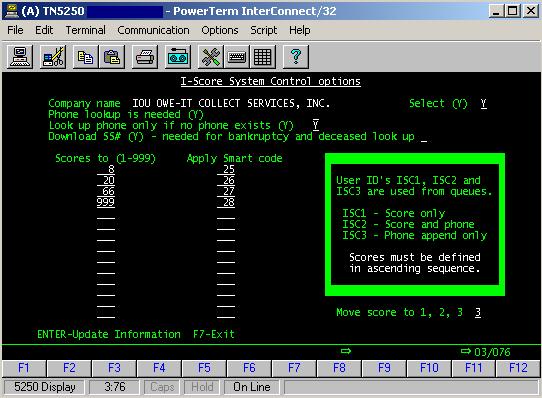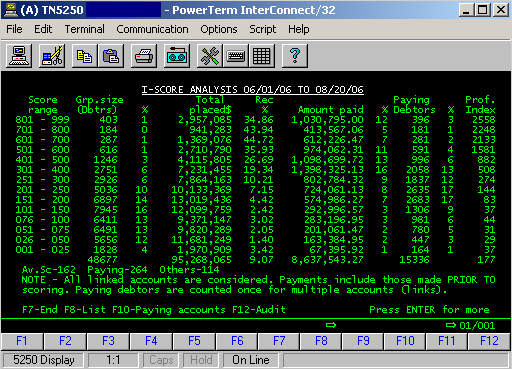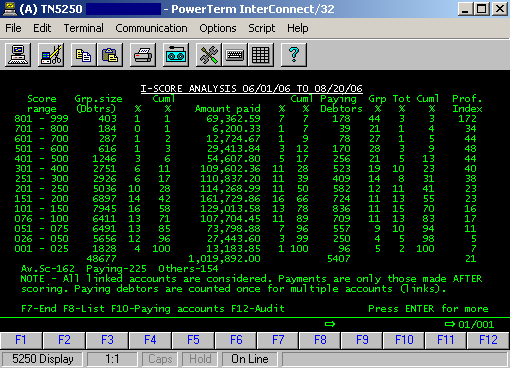|
DOCUMENTATION
FOR I-SCORE
 Quantrax
will support I-Score as base code in Version 8.1 of Intelec. Users
who are on prior versions will run the processes described in a
different manner from Intelec 8.1 users. Quantrax
will support I-Score as base code in Version 8.1 of Intelec. Users
who are on prior versions will run the processes described in a
different manner from Intelec 8.1 users.
You will first work with Quantrax who will create models and analyze
your data. This will help you to understand if scoring your accounts
using I-Score can produce results for you or not.
Setting up the scoring process involves the following.
- When you
decide to use Quantrax for scoring, you will need processes to
select the accounts that need to be scored on a daily basis
- Quantrax
will create a file of the accounts to be scored and move the information
to a server at their office
- Accounts
will be scored and returned to you along with the scores.
- Programs
will read the scores, save them on the system and apply Smart
Codes based on rules that you set up
- There will
be statistics of accounts scored and payments generated from the
scored accounts
This documentation
will provide more details on the above.
Once you have
talked to Quantrax about having your accounts scored, they will
notify you when the programs have been set up on your system. When
the programs are activated you will have access to a new system
control file for scoring. You also have a little work to do to get
the process started.
Here are the required steps.
- Make a decision
about how you want to move accounts into the scoring process.
You can have complete control of the process and simply ask Quantrax
to work all of the accounts in User ID ISC1 (User ID used for
scoring only). We will be offering phone look-ups and there will
be different User ID's that will be used, based on the level of
service required. You can place some accounts in User ID ISC1's
queue through the use of Smart Codes and a change of worker code,
and also ask Quantrax to automatically add new business to the
scoring process based on certain parameters (during the nightly
processing).
- If you want
Quantrax to processing all your new business, Quantrax will use
programs that will read all the new accounts for the day. You
will need to tell us what company codes should be considered.
You can specify a minimum linked balance to be considered (we
suggest that all accounts are scored, regardless of balance) and
a description code that will omit the account (if that code exists
on any of the links). The description code could be applied to
accounts that you may not want scored (e.g. accounts previously
scored). You would add this description code when the account
is returned to you after it was scored or at the time it was sent
for scoring. The options for selecting accounts for scoring are
one of the following.
- Change
the worker code one that is associated with a User ID of "ISC1".
In this case, you will have to provide a Smart Code to apply
to the new business that qualifies to be scored. You also
need to give us the worker code that is associated with User
ID "ISC1". You can also use Smart Code though options
such as the multiple Smart Code assignment to move accounts
to the queue for ISC1.
- Another
method is for Quantrax to analyze all of the the new business
for the day (during nightly processing) based on the company
code, a minimum linked balance and a description code to be
used to omit an account. In this case it is not necessary
to supply a Smart Code. The account can remain with the existing
worker code and User ID and can be scored and returned for
you to take the necessary action.
Note that if there are multiple linked accounts for the same
debtor, we will only score the debtor and count the account
once.
Summary - To have Quantrax select accounts from within your
new business, you will need to give us
- the company
codes to be considered,
- a minimum
linked balance to look for,
- a description
code to omit accounts,
- a Smart
Code to apply to move the account to the worker code associated
with User ID ISC1 (only if you want to change the worker code
or update the account in some way) and
- the code
in Intelec for the worker that is associated with the User ID
ISC1. (This should be provided if you move accounts to that
worker code and want them to be included in the scoring)
- You will
need a Smart Code that you can use to have existing accounts scored
(e.g. through a multiple Smart Code assignment). If you set up
a Smart Code for new business, you can use the same Smart Code
for this too (We can select new business without using any Smart
Codes, as described earlier). You could duplicate the Smart Code
on linked accounts and keep all of the linked accounts in the
scoring worker code. Since accounts would be scored quickly depending
on volumes, you can have us select from all the new business and
not move the accounts into a special worker code.
- You will
need to set up Smart Codes to be applied to the accounts once
they are returned after being scored. Quantrax will talk to you
about your environment and the score ranges from the accounts
that were tested. You will need to set up codes for the different
ranges of scores based on your workflows. Following is the screen
displayed when the System Control file for I-Score is displayed
by taking option 15 from the 3rd System Control menu in Version
8.1, or by keying in the following from a command line for all
prior releases.
call
uiscor

- The system
control file must be set up for all companies where scoring
is required. When we do out initial tests, we have to create
the system control information. You may therefore find some
of the information already set up.
- "Select
(Y)" is required to set up scoring for a specific company
- "Phone
lookup is needed (Y)" should be set up when you start
using the phone lookup service along with the scoring
- "Download
SS# (Y)" is only required if you require the bankruptcy
and deceased lookup options
- Based
on the scores obtained from the analysis done by Quantrax,
you can define up to 14 scores and the corresponding Smart
Codes to be applied. You must set up the scores in
ascending sequence. You should always set up the last
score as 999, so that all scores have a Smart Code. (We will
provide scores in the range 1 - 999.) You can set up the Smart
Code to do anything, but it is recommended that you duplicate
the Smart Code (so all of the linked accounts move together)
and also add a description code that will be used to stop
the account from being scored over and over again. We will
later provide options for re-scoring accounts based on the
last time an account was scored.
- You can
save the I-Score value in one of the 3 Intelec scores and
use it for decision-making. Set up the score field to be used
in the option "Move score to 1, 2, 3". The 3 scores
we refer to are displayed on the 2nd account detail screen,
reading from left to right.
-
Once the
system control files have been set up for each company, you
are ready to start scoring accounts. At the beginning of nightly
processing, we will take the last scores that were "uploaded"
and apply Smart Codes and save the scores on the accounts (all
linked accounts) based on the system control file. We plan to
run a "download" (get accounts that need to be scored)
at the end of the nightly process. We plan to download the the
accounts to be scored into our servers, around 8 AM EST. We
expect the accounts to be scored and information moved to your
system by 5 PM EST, well in time for your nightly processing.
Initially, we may use the iSeries modems, but we will work towards
an FTP process to move the files between the systems.
-
Analyzing
collection results based on the scores is also easy. We provide
reports that show paying accounts based on the range of scores,
as in the following example. In this option, we look at all
the linked accounts related to the accounts scored, taking into
account all the accounts placed (amount placed, regardless of
close codes) and the amounts collected from all of the accounts
regardless of the time frame (could have been before the accounts
were scored). The objective is to evaluate the accuracy of the
scores against accounts where payments were made. There are
other reports that only include payments received after the
accounts were scored.
To access the reports, from Version 8.1 and later, key in "IS"
(letter i and s) at any menu. Management Menu access will be
required. For prior releases, key in the following from a command
line
call iscorpcl
As you look at the screens and begin to think about how you
could incorporate scoring into your business model, you should
consider the following.
- No
scoring model can claim to accurately tell you who will and
will not pay.
- There
will always be collectable accounts that will be scored low.
Similarly, you will not collect from many high-scoring accounts.
- Scores
are an indicator and you are always responsible for evaluating
the reliability of any scoring system.
- Our
goal is to provide reliable results for a very large percentage
of the accounts scored.
- Giving
a lower score to some collectable accounts is not damaging
if those accounts get collected quickly or with a little effort
compared to the success with other low-scoring accounts. You
could consider using an additional credit score on some of
the lower-scoring high balances, to find out if they may qualify
to be considered more collectable.
- Assigning
higher scores to accounts that can not be collected will not
be costly if the number of accounts is small. You will have
fewer high scoring accounts and you will not be using a large
percentage of your resources on these accounts.
- Numbers
can also be deceptive. A single large payment can skew the
analysis and this must be considered carefully. In general
if a collectable account was placed in a low-scoring group,
there is a good chance that the account would be recovered
with minimal effort. While it is our recommendation that additional
resources and time be allocated for higher-scoring accounts,
we do not suggest that you put no effort on the lower-scoring
accounts! These accounts must also be worked, but worked economically.
In the following, Prof.Index is a profitability index. It
looks at the amount paid for each group, compared to the number
of accounts in the group. Assuming you put the same resources
into all of the accounts in the group, this index is an indication
of the amount collected per debtor, for accounts within the
group. The larger the number, the more profitable those accounts
are likely to be.

In the above, looking at all of the linked accounts
(some of the accounts for the same debtor could be much older than
the new account that was scored) and all the payments
that were received to date, allows you to evaluate the new scores
based on prior collection efforts for the same debtors. If most
of the payments were against accounts that had lower scores, you
would obviously question the accuracy of the scores. In the example
above, a larger amount and number of payments have been generated
from the accounts with higher scores.
Now, let us look at the same group of accounts, but only consider
payments received after the accounts were scored.
Note the increase in the percentages of amounts paid and paying
debtors as the scores increase.
- Grp% is
the percentage of paying debtors calculated against the group
size.
- Tot% is
the percentage of paying debtors calculated against the total
number of paying debtors for all groups.
- Cuml.
% shows percentages for all the groups up to and including the
group referred to on that row.

-
The above
lists can be analyzed in more detail using the options that
allow you to list all the accounts (F8) or only the paying accounts
(F10) for a particular score range. In addition, you can select
a score range and work with those accounts through the account
audit feature (F12)! From within the account list you can select
and sort using the many options offered by the account audit
making the entire process very flexible and completely integrated
with Intelec.
For more information,
please e-mail ranjan@quantrax.com

|

